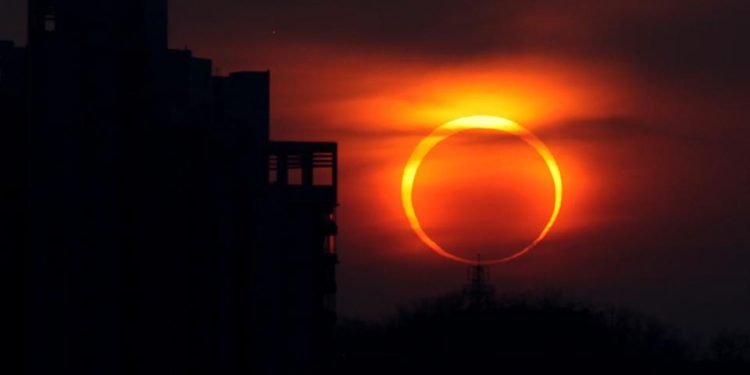Nikunja Bihari Sahu
A rare celestial spectacle is going to unfold with an annular solar eclipse looming large December 26, 2019. While the annularity will be passing over a broad belt stretching from Saudi Arabia to Guam, it will be visible to parts of Southern India. However for the rest of the country, including Odisha, the eclipse will be partial. This is the third and final solar eclipse of the year; it was preceded by a partial solar eclipse January 6 and a total solar eclipse July 2. An Annular Solar Eclipse happens when the Moon covers the Sun’s centre and leaves the outer edges to form a ring of fire or annulus around the Moon.
A solar eclipse usually occurs on New Moon day when the Moon lies between the Sun and the Earth in a straight line, blocking the Sun to cast a shadow on the Earth. While the Sun completely vanishes from the sky during a Total Solar Eclipse, causing temporary nightfall, a partial eclipse is marked by an incomplete obstruction of the Sun by the Moon. Among the notable solar eclipses Odisha has witnessed in the past were a total eclipse of February 16, 1980, and a partial eclipse of October 24, 1995.
Although annular or total solar eclipses are not rare, few people have really had a chance to witness the event in their lifetimes. The reason behind this paradoxical phenomenon is that such eclipses are usually seen over a very narrow strip sometimes passing over seas and inaccessible parts of the globe. Observing a solar eclipse, therefore, becomes really a lifetime experience. It should be enjoyed and celebrated.
However, safe observation is necessary to view the eclipse. Looking directly at the Sun with naked eyes or through unprotected telescopes or binoculars can cause eye damage and even permanent blindness. Traditional method of viewing the Sun in turmeric water during the eclipse is highly unsafe and unscientific as it does not cut off all the harmful ultraviolet and infrared radiation from the Sun and should never be practiced. Special filter glasses that cut off 99 per cent of the Sun’s visible rays and block all harmful infrared and ultraviolet radiations can allow us to view the phenomenon safely. However, the best way to view the Sun safely is to project its image on a screen with the help of a telescope or binocular and observing the progressive stages of the eclipse.
Through the ages, the sudden darkening or disappearance of the sun has been seen as a sign of displeasure of Gods or an omen of turbulent activities. In Chinese mythology, an eclipse is interpreted as a dragon devouring the Sun in the sky. In our Indian mythology, two hungry demons named Rahu and Ketu are believed to be swallowing the Sun during the eclipse. There are many myths prevalent in our society regarding the eclipse. People used to observe penance and fasting during the eclipse as it is believed that the food cooked during the eclipse turns toxic. Pregnant women are advised to stay indoors in the belief of harmful impacts of the eclipsed rays on the unborn baby. People are also advised not to embark on distant journeys during the eclipse. Rituals of deities are altered due to the eclipse. People used to take bath and offer pujas at temples after the eclipse.
Grand celestial spectacles are not generally welcomed in our dogma-dominated society. What really disturbs is the unchanging mindset of people even in the light of convincing scientific evidences put forward to explain these celestial phenomena? It is quite ridiculous to shut oneself indoors when a spectacular and a rare natural event is unfolding up in our backyard. We can never shy away from such celestial challenges, but be a part of the drama. We should not only free ourselves from these bizarre beliefs, but also develop a sense of curiosity and scientific mindset to unravel the mystery of nature.
–The writer is education officer, Regional Science Centre, Bhopal.







































